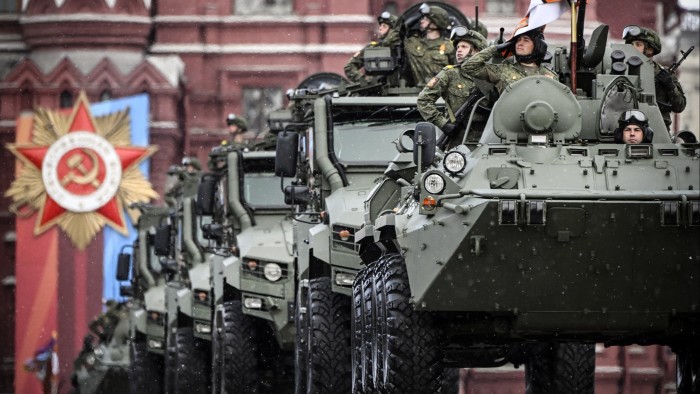Stay informed with free updates
Simply sign up to the War in Ukraine myFT Digest — delivered directly to your inbox.
Military spending in Russia, whose economy President Vladimir Putin has put on a war footing, now outstrips all of Europe’s defence budgets combined, according to a study.
Total Russian defence spending soared last year by 42 per cent in real terms to Rbs13.1tn. That is equivalent to $462bn on the basis of purchasing power parity, which adjusts for what currencies can buy in their home countries.
European defence budgets by comparison, including the UK and EU member states, rose by almost 12 per last year to $457bn — slightly less than Moscow’s spending, the International Institute for Strategic Studies think-tank said on Wednesday.
The IISS’s “Military Balance”, an annual assessment of global military capabilities and defence spending, lays bare some of the security challenges facing Europe should the US cut back its support for Ukraine and European defence.
US President Donald Trump, who has vowed to bring a swift end to Russia’s war against Ukraine, has said his administration had held “very serious” talks with Moscow and has complained that the US is spending too much on the conflict and European security as a whole.
Senior advisers in Trump’s administration, including vice-president JD Vance and special envoy Keith Kellogg, are expected to meet Ukrainian President Volodymyr Zelenskyy and European counterparts at the Munich Security Conference this week.
One metric that Trump has repeatedly cited is the need for Europe to pay more for its defence, including support for Ukraine. US aid to Ukraine has so far totalled about €88bn, according to the Kiel Institute for the World Economy think-tank, which is almost a third less than Europe’s €125bn total.
Trump has also said Europe should spend 5 per cent of GDP on defence, compared with its current average of about 1.7 per cent. Nato secretary-general Mark Rutte has, meanwhile, said European defence spending needs to rise to 3 per cent.
Either level would see Europe far outstrip Russian defence spending.
The IISS forecast that this year total Russian defence spending — including so-called voluntary payments by regional authorities and companies — would increase by 13.7 per cent to reach Rbs15.6tn, equivalent to 7.5 per cent of GDP or almost 40 per cent of Russian federal spending.
Although this was taking a toll on the economy, IISS said: “Russia can still bear the costs of war.”
By contrast, if Europe increased defence spending to 3 per cent of GDP, that would equate to an extra $250bn, according to IISS. If it rose to 5 per cent of GDP, defence spending would rise by about $800bn — almost twice Russia’s current level of spending.
However, European defence spending had already grown by a half since 2014, IISS said, and “fiscal constraints may dampen [further] growth”.
Germany’s defence budget rose by 23 per cent to reach $86bn — topping the UK’s defence budget of $81bn for the first time in more than three decades.
However, that was due to one-off payments from a special German defence fund. Sustaining that level was “subject to a higher degree of uncertainty,” IISS said. Germany’s commitment to spend 2 per cent of GDP by 2029, compared with 1.8 per cent now, was “also uncertain”, it added.
The UK, traditionally Nato’s second-biggest defence spender after the US, currently spends 2.3 per cent of GDP on defence. The government has said it is committed to boosting that to 2.5 per cent, although it has not said when.
French defence spending, traditionally Europe’s second largest in absolute terms, rose by 4.5 per cent to $64bn last year, equivalent to 2 per cent of GDP.
Among Europe’s biggest defence spenders, Estonia, which borders Russia, spent almost 4 per cent of GDP on defence last year, with Poland at 3.25 per cent being Europe’s second highest. But their absolute levels of defence spending were far smaller than Europe’s three biggest economies, at $1.7bn and $28bn respectively.
Read the full article here




